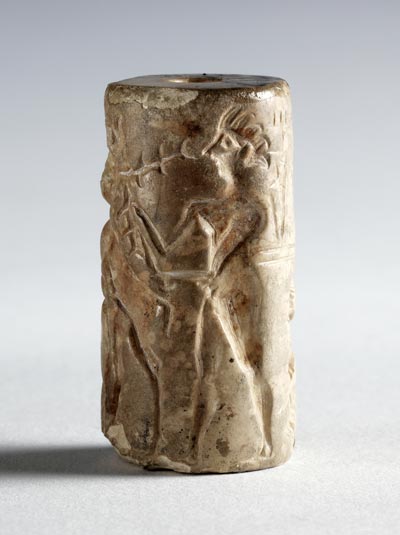
Sarah Jarmer Scott, associate professor of art history and dean of integrated learning, has been studying the seals of ancient Mesopotamia ever since her graduate school days at the University of Pennsylvania.
That university’s large museum collection was acquired in the 1930s, when a team of scholars from Penn helped to excavate the ancient city of Ur. While some were focused on the precious metals and gems of an elite burial site, others collected “sealings” — that is, clay pieces on which seals were impressed — that had been discarded on the same spot.
A new book that Scott co-edited, Seals and Sealing in the Ancient World: New Approaches to Glyptic Studies (Cambridge University Press, 2018), showcases the vast amounts of information about ancient religious views, social status, and communication that scholars glean from these tiny objects.
In Scott’s chapter of the book, she focuses on a type of seal that is shaped like a hollow tube — the cylinder seal. Like stamp seals, which have an even longer history, cylinder seals were carved with imagery and impressed on objects for various purposes.

Seals originated around 7,000 BCE to express their owners’ religious rank and shamanic powers. Inscribed with anthropomorphic animals and geometrical shapes, the seals may have evoked their owners’ ability to cross boundaries between people and animals, or between the material and the spiritual world.
Scott writes about that moment in history when the use of seals intersected with the advent of cuneiform writing. Both were used to convey information, while increasing urbanism and commodity exchange changed the cultures of ancient Mesopotamia — an early “revolution in communication,” Scott says. During this time period — around 3,500 to 500 BCE — seals increasingly became a part of trade, carrying information about ownership, content, and even measurements or quantities.
Seals Today
“The use of seals for identity and transfer of authority is the same now as it was in ancient Mesopotamia,” Scott notes.
Scott points out the connection between the clay used in seals and sealing, clay’s religious significance as the material from which the gods made humans, and the seals’ ability to act as authority-bearing agents for people.
That notion still has modern relevance, she says. Having a document notarized, for instance, is a modern way of using a seal to represent a person’s physical presence, identity, and authority.
In another modern parallel, giant statuary or other imagery of gods in ancient temples were miniaturized on seals. In the same way, images associated with institutions are miniaturized on modern seals to convey the power or authority of that institution.
“Wearing the seal, on a pin for example, is remarkably similar to antiquity. What we wear is carefully curated. It’s a sign of allegiance or support of the idea that image represents,” she says. “It’s a way to show your kinship.”
In ancient times, the seal was also a sign of authority. If you imprinted your seal on something or someone, it showed your ownership or authority over that thing or person.
That’s why Scott is fascinated by objects like Main Hall’s old brass doorknobs embossed with the College’s name. “It’s a visceral, physical embodiment of the institution when you touch it and open the door,” she says.
“I think people today are visually literate in a way that’s similar to the ancients, but we can process images faster now. The ancients were better at processing details. They saw a lot fewer images than we do today.”



